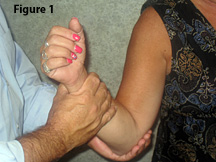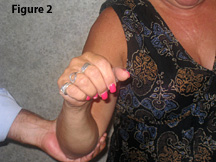Two primary ways of testing for rotator cuff ruptures is to determine whether the shoulder has enough strength to maintain a position against resistance, and by passive testing whereby the examiner attempts to determine if a passive position can be maintained in space (Lag sign).
A recent study2 revisited the external rotation lag sign (ERLS). This test evaluates the integrity of both the supraspinatus and infraspinatus tendons. The ERLS is performed in the seated or standing position with the patient's elbow passively flexed to 90 degrees and the shoulder abducted to 20 degrees in the scapular plane, and near-maximal external rotation (minus a few degrees to avoid elastic recoil of the joint capsule or scapulothoracic joint caused by the examiner).
 The examiner supports the elbow joint and holds the patient's wrist (Figure 1). The examiner then removes their hand from the wrist and asks the patient to actively maintain this position. If the patient cannot maintain original position against gravity and their arm rotates internally, the test is positive (Figure 2). The study2 concluded that this ERSL was "a useful sign for the diagnosis of isolated full thickness tears of the supraspinatus tendon." The amount of internal rotation lag for an isolated supraspinatus rupture was 7.35 degrees ± 3.12 degrees. This test should be compared with the contralateral side.
The examiner supports the elbow joint and holds the patient's wrist (Figure 1). The examiner then removes their hand from the wrist and asks the patient to actively maintain this position. If the patient cannot maintain original position against gravity and their arm rotates internally, the test is positive (Figure 2). The study2 concluded that this ERSL was "a useful sign for the diagnosis of isolated full thickness tears of the supraspinatus tendon." The amount of internal rotation lag for an isolated supraspinatus rupture was 7.35 degrees ± 3.12 degrees. This test should be compared with the contralateral side.
 There was a strong correlation between the extension of the tear and the amount of the lag. As the lag (internal rotation) increases, there is most likely tearing of the infraspinatus and teres minor. For tears of the supraspinatus extending to superior and inferior portion of the infraspinatus, the lag was 17.76 degrees ± 9.55 degrees. If the teres minor is torn, the degree of internal rotation goes to 26.25 degrees ± 16 degrees.
There was a strong correlation between the extension of the tear and the amount of the lag. As the lag (internal rotation) increases, there is most likely tearing of the infraspinatus and teres minor. For tears of the supraspinatus extending to superior and inferior portion of the infraspinatus, the lag was 17.76 degrees ± 9.55 degrees. If the teres minor is torn, the degree of internal rotation goes to 26.25 degrees ± 16 degrees.
The ERLS could not identify partial tears of the supraspinatus. The tests were confirmed by either arthroscopic or open surgery. The sensitivity was 56 percent and the specificity was 98 percent, meaning that if the test were negative, there was a 98 percent probability that there was not a full-thickness tear.
The ERLS test should be added to the tests recommended by the Parks, et al., study3 that found a 91 percent probability for full-thickness rotator cuff tears when there was a combination of a painful arc sign, drop-arm sign and a positive infraspinatus muscle test. For the drop-arm sign, the examiner holds the affected arm at 90 degrees of abduction (in the scapular plane) and at almost full external rotation, with the elbow flexed at 90 degrees. In this position, maintenance of the position of external rotation of the shoulder is a function primarily of the infraspinatus, but also stresses the supraspinatus. The patient is then asked to actively maintain this position as the examiner releases the wrist while supporting the elbow. The sign is positive if a lag or "drop" occurs. The magnitude of the lag is recorded to the nearest 5 degrees.
The lag sign for the subscapularis is performed with the patient's arm held in the lift-off position (behind their back, elbow flexed to 90 degrees, shoulder abducted 20 degrees, and extended 20 degrees). Examiner passively lifts the dorsum of the patient's hand away from the lumbar region until almost full internal rotation is achieved. The patient is then asked to actively maintain this position while the examiner, who is supporting the elbow, releases the patient's wrist.
If the patient cannot maintain the position and a lag toward the lumbar area occurs, then the subscapularis is ruptured. A slight lag indicates a partial tear of the cranial part of the subscapularis tendon, while an obvious drop of the hand may indicate a large tear.1
References
- Hertel R, Ballimer FT, Lambert SM, Gerber C. Lag signs in the diagnosis of rotator cuff rupture. J Shoulder Elbow Surg, 1996;5:307-313.
- Castoldi F, Blonna D, Hertel R. External rotation lag sign revisited: accuracy for diagnosis of full thickness supraspinatus tear. J Shoulder Elbow Surg, 2009;18:529-534.
- Park HB, Yokota A, Gill HS, et al. Diagnostic accuracy of clinical tests for the different degrees of subacromial impingement syndrome. J Bone Joint Surg (U.S.), 2005;87:1446-55.
Click here for previous articles by Warren Hammer, MS, DC, DABCO.





